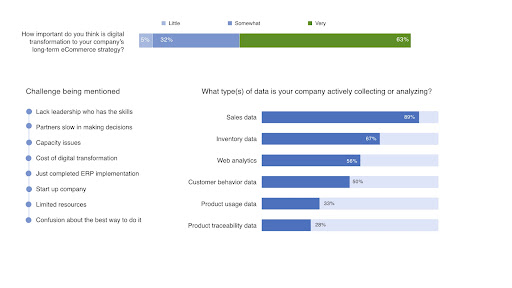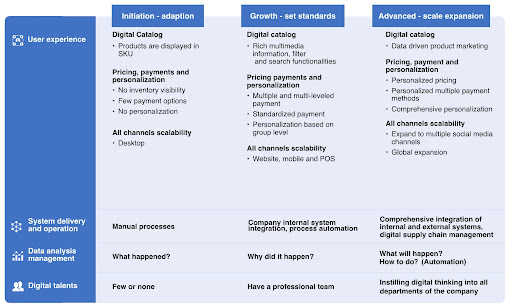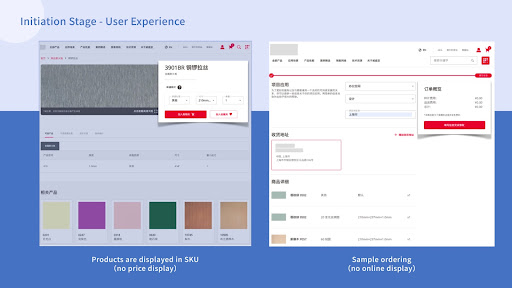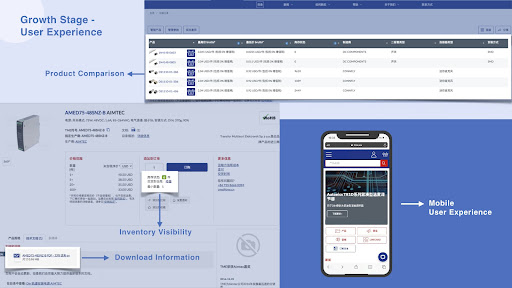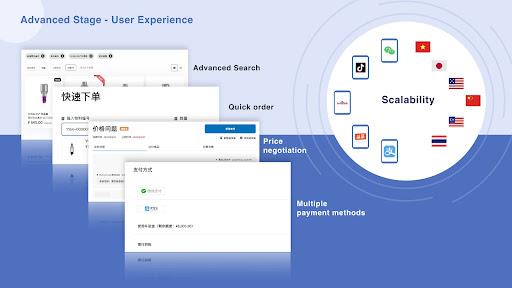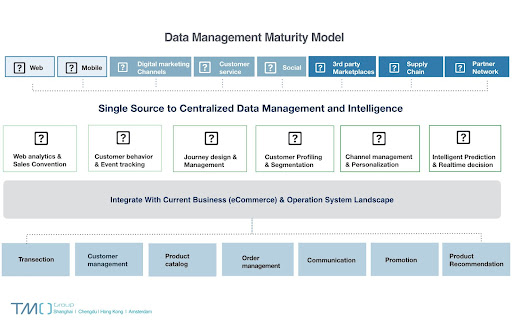In the first article of our 8-part series on conducting B2B eCommerce in China, we discussed digital transformation. In this article, we will explore how companies can evaluate their digital maturity while entering the B2B eCommerce arena.
According to a recent survey that TMO Group conducted among eCommerce professionals, most respondents believe that digital transformation plays an important role in the long-term eCommerce strategy of companies. We also list some of the main challenges that companies face, and what type of data companies actively collect or analyze, for your reference.
Starting an eCommerce operation can serve as a launchpad for a company’s digital transformation. However, the level of digital maturity a company possesses will ultimately determine its success in eCommerce. The higher a company’s digital maturity level, the better it can manage competition risks, convert users, and increase online sales. The following aspects can be used to evaluate a company’s digital maturity:
- User Experience
- System Delivery and Operation
- Data Analysis Management
- Digital Talents
1. Initiation Stage
1.1 User Experience
Digital Catalog
- Products are displayed as SKU, including product ID and basic specifications.
- No price or inventory visibility
- A simple picture of the product, or none at all.
- Contact form
- Telephone or email inquiry
- No price or range displayed
- No option to purchase products online
- Sample ordering (without online transaction)
- No personalization
Channel Scalability
- Single channel (most of the time a desktop website, but sometimes a mobile app)
- Little or no social media presence
1.2 System Establishment, Delivery, and Operation
The sales and fulfillment processes in the company are primarily performed manually by its employees. The platform systems used by the company operate independently of each other, which means that data cannot be synchronized between them. The eCommerce, ERP, CRM, and warehousing operations are all carried out separately without integration. This setup leads to high labor costs since tasks, such as sales freight or order bill, require manual input from employees, leaving room for errors. However, implementing an ERP system can automate many of these tasks and integrate them into the system workflow, reducing the potential for errors and increasing efficiency.
1.3 Data Management and Analysis
The eCommerce data collected is primarily centered around website traffic, page statistics, and basic user browsing behavior. This data is then analyzed to determine “what happened”. Data analysis is conducted by reviewing dashboards and reports to extract insights. However, in many cases, business decisions are still based on assumptions about unanalyzed data.
1.4 Digital Talent
It is likely that companies may not have extensive IT and digital capabilities, and the majority of their employees may have more experience with traditional offline work than digital operations. As a result, their focus may be primarily on marketing and business development rather than digital initiatives.
2. Growth Stage
2.1 User Experience
Digital Catalog
- Additional product information beyond SKU
- More search options for products
- Product filtering and comparisons – it goes beyond product categories into more detailed product features
- Multimedia product information, such as pictures, videos, PDF downloads, etc.
- Recommendations based on product relevance
- Online customer service
Pricing, Payment and Degree of Personalization
- Tiered pricing
- Customer group pricing
- Standardized payment methods, fixed price online payment, offline cash on delivery, or B2B company credit
payments - Standardized online sales processes
- Customer account dashboards, including order status tracking
- Personalized functionalities such as loyalty points, business lines of credit
Channel Scalability
- An expansion from desktop website to an optimized mobile experience, and offline POS terminal
- A consistent user journey across different channels
- Omni-channel delivery/process tracking
2.2 System Establishment, Delivery and Operation
In order to automate manual tasks, the ERP system should be the primary source of data for integrating various eCommerce platforms like CRM and WMS systems. This allows for the simplification and optimization of organizational workflows, including those related to finance and logistics. The efficiency and time effectiveness of these processes can be evaluated comprehensively. All business departments should collect feedback and adjust their processes in an integrated manner.
- Integration of back-end systems such as ERP
- Real-time inventory visibility
- Real-time warehouse and third-party logistics tracking
- Provide return and exchange service for customers
- E-fapiao processing capability
2.3 Data Management and Analysis
As companies gather more data from various touchpoints, including products, user behavior, and operational processes, they can turn customer-related data into actionable insights to personalize the customer experience and meet their expectations. This requires the transition from analyzing “what happened” to “why did it happen” through diagnostic analysis, which involves identifying patterns in data by segmenting it into multiple categories or performing sentiment analysis. To unlock this potential, companies need personnel and software capable of generating these insights. As a company becomes more digitally mature, diagnostic tasks can also be solved through data mining and machine learning techniques.
2.4 Digital Talent
Companies will by now have teams with IT expertise and digital thinking capabilities. All departments of the company will need to appoint personnel who can coordinate digital transformation.
3. Advanced Stage
3.1 User Experience
Digital Catalog
Data-driven product marketing
- A wide array of product categories, meaning customers can look very specifically for what they want, and enhancing the shopping experience
- Automated, unique product recommendation and personalization for individual customers based on the AI engine
- Advanced search options, such as by product specifications, making the purchasing process more accurate and efficient for users
- Support multi-market, multi-currency, multi-language and localized catalogs
- Being able to manage products efficiently using a Product Information Management (PIM) system
Pricing, Payment and Degree of Personalization
- Customized price lists
- Personalized, exclusive offers for customers
- Price negotiation
- Multiple payment methods:
- Online payment
- Offline payment (bank transfer, purchase order, credit limit)
- More personalized B2B order models, such as subscriptions or recurring orders
- Quick orders, re-order and requisition orders
- Intelligent online customer service
- Customized company account registration
Figure 2.5: User experience in the advanced stage of digital maturity
Channel Scalability
- Multichannel social media is supported, for example with WeChat, Weibo, Baidu, in China.
- Multimarket expansion, including multi-languages, currencies and market localization.
- A complete virtual inventory of products online.
3.2 System Establishment, Delivery, and Operation
- API orchestration allows for greater integration with external supply chain partners, automating workflows and reducing manual input for higher accuracy and efficiency.
- AI and big data are used for scheduling and optimizing freight management and delivery, which allows for the optimization of freight rates, as well as integrating company data and processes.
- The usage of a PIM system provides companies with a centralized location to collect, manage, and enrich complex product catalog information for distribution across online and offline channels. This ensures company-wide consistency in product information, complementing the more basic information acquired from SKU/SPU-based systems such as the company’s ERP or Order Management System (OMS).
- The sales team follows up with customers through mobile CRM systems, and clienteling can solidify long-term relationships between the company and the customer. Furthermore, AI-powered chatbots primarily support customer service and after-sales, optimizing the sales funnel with 24/7 support and immediate answers to customer queries.
- Through quantitative supply chain optimization, the company leverages its digital resources to optimize supply chain operations. Companies can partner with distributors to offer offline services such as after-sales and installations.
- The partner ecosystem, incorporating marketing, consulting, and financing, is integrated to provide more efficient and transparent services.
- All company departments use a single sign-on (SSO), improving data security and lowering IT costs.
3.3 Data Management and Analysis
As companies reach an advanced level of digital maturity, two forms of AI and big data-driven analysis become increasingly important: predictive analysis and normative analysis.
Predictive analysis aims to answer the question of “what will happen” by capturing patterns from historical data and movable assets. Companies can use predictive analysis to predict whether a user will churn, how a product should be priced, or how long it will take for a machine to be serviced under current workload conditions. This type of analysis is typically achieved through machine learning.
Normative analysis, on the other hand, provides recommendations or views on what actions should be taken to solve a problem. For example, a platform can gather external data on the credibility and risk scores of new users and provide recommendations on whether to decline or prepay orders for certain customers. Normative analysis helps companies make informed decisions based on data-driven insights.
3.4 Digital Talent
Digital is at the core of the company’s work culture. eCommerce is now fundamentally decentralized, with every team possessing certain digital skills for autonomous assessment and for devising key strategies.
Data Management Maturity Model
As a data-driven eCommerce technology service provider, TMO Group focuses on helping companies build data assets toward data management. The model for the evolving process of data management is attached for your reference. It will be explored in more detail in our next eCommerce guide.
B2B eCommerce Implementation Roadmap
To implement B2B eCommerce, here is a four-step roadmap:
- Step 1: Create a complete digital product catalog and focus on building a seamless user experience for product navigation, filtering, and search. Provide comprehensive product and brand information and enable users to submit inquiry requests to understand their interests and needs.
- Step 2: Provide new sales channels to reach new customers and maintain existing ones, and automate sales through standardized and streamlined online purchasing workflows similar to those used by Taobao.
- Step 3: Optimize eCommerce operations and sales through in-depth localization and B2B-specific features. Reduce service response times, implement personalized pricing and delivery processes, and establish an account-level sales structure to better serve B2B customers.
- Step 4: Replicate the success of one market in another and adopt new digital business models to meet changing market demands.
If you would like to know what stage your company is currently in:
- Contact UsWant to know more about our E-Commerce solutions? Interested in creating a multi-channel strategy? Contact our E-commerce agency in Shanghai Hong Kong AmsterdamContact TMO Group for a consultation. Our skilled team of experts are on hand to help you with your B2B eCommerce needs.

